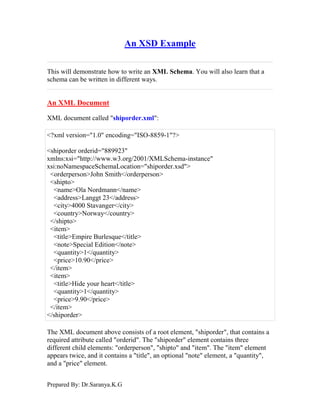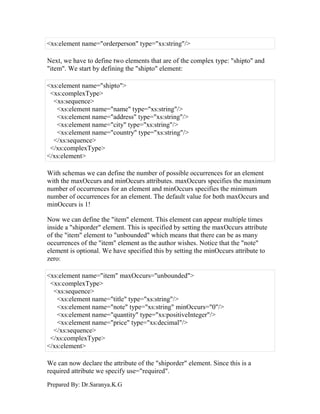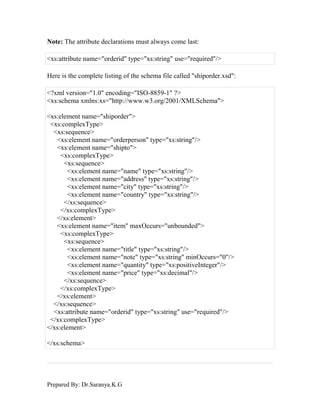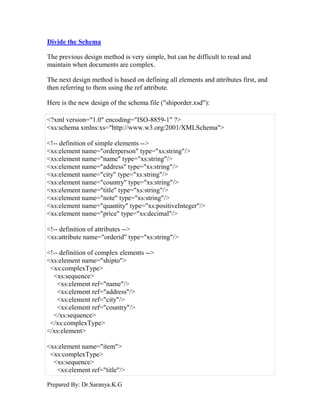3-SchemaExamples.pdf
- 1. Prepared By: Dr.Saranya.K.G An XSD Example This will demonstrate how to write an XML Schema. You will also learn that a schema can be written in different ways. An XML Document XML document called "shiporder.xml": <?xml version="1.0" encoding="ISO-8859-1"?> <shiporder orderid="889923" xmlns:xsi="http://www.w3.org/2001/XMLSchema-instance" xsi:noNamespaceSchemaLocation="shiporder.xsd"> <orderperson>John Smith</orderperson> <shipto> <name>Ola Nordmann</name> <address>Langgt 23</address> <city>4000 Stavanger</city> <country>Norway</country> </shipto> <item> <title>Empire Burlesque</title> <note>Special Edition</note> <quantity>1</quantity> <price>10.90</price> </item> <item> <title>Hide your heart</title> <quantity>1</quantity> <price>9.90</price> </item> </shiporder> The XML document above consists of a root element, "shiporder", that contains a required attribute called "orderid". The "shiporder" element contains three different child elements: "orderperson", "shipto" and "item". The "item" element appears twice, and it contains a "title", an optional "note" element, a "quantity", and a "price" element.
- 2. Prepared By: Dr.Saranya.K.G The line above: xmlns:xsi="http://www.w3.org/2001/XMLSchema-instance" tells the XML parser that this document should be validated against a schema. The line: xsi:noNamespaceSchemaLocation="shiporder.xsd" specifies WHERE the schema resides (here it is in the same folder as "shiporder.xml"). Create an XML Schema Now we want to create a schema for the XML document above. We start by opening a new file that we will call "shiporder.xsd". To create the schema we could simply follow the structure in the XML document and define each element as we find it. We will start with the standard XML declaration followed by the xs:schema element that defines a schema: <?xml version="1.0" encoding="ISO-8859-1" ?> <xs:schema xmlns:xs="http://www.w3.org/2001/XMLSchema"> ... </xs:schema> In the schema above we use the standard namespace (xs), and the URI associated with this namespace is the Schema language definition, which has the standard value of http://www.w3.org/2001/XMLSchema. Next, we have to define the "shiporder" element. This element has an attribute and it contains other elements, therefore we consider it as a complex type. The child elements of the "shiporder" element is surrounded by a xs:sequence element that defines an ordered sequence of sub elements: <xs:element name="shiporder"> <xs:complexType> <xs:sequence> ... </xs:sequence> </xs:complexType> </xs:element> Then we have to define the "orderperson" element as a simple type (because it does not contain any attributes or other elements). The type (xs:string) is prefixed with the namespace prefix associated with XML Schema that indicates a predefined schema data type:
- 3. Prepared By: Dr.Saranya.K.G <xs:element name="orderperson" type="xs:string"/> Next, we have to define two elements that are of the complex type: "shipto" and "item". We start by defining the "shipto" element: <xs:element name="shipto"> <xs:complexType> <xs:sequence> <xs:element name="name" type="xs:string"/> <xs:element name="address" type="xs:string"/> <xs:element name="city" type="xs:string"/> <xs:element name="country" type="xs:string"/> </xs:sequence> </xs:complexType> </xs:element> With schemas we can define the number of possible occurrences for an element with the maxOccurs and minOccurs attributes. maxOccurs specifies the maximum number of occurrences for an element and minOccurs specifies the minimum number of occurrences for an element. The default value for both maxOccurs and minOccurs is 1! Now we can define the "item" element. This element can appear multiple times inside a "shiporder" element. This is specified by setting the maxOccurs attribute of the "item" element to "unbounded" which means that there can be as many occurrences of the "item" element as the author wishes. Notice that the "note" element is optional. We have specified this by setting the minOccurs attribute to zero: <xs:element name="item" maxOccurs="unbounded"> <xs:complexType> <xs:sequence> <xs:element name="title" type="xs:string"/> <xs:element name="note" type="xs:string" minOccurs="0"/> <xs:element name="quantity" type="xs:positiveInteger"/> <xs:element name="price" type="xs:decimal"/> </xs:sequence> </xs:complexType> </xs:element> We can now declare the attribute of the "shiporder" element. Since this is a required attribute we specify use="required".
- 4. Prepared By: Dr.Saranya.K.G Note: The attribute declarations must always come last: <xs:attribute name="orderid" type="xs:string" use="required"/> Here is the complete listing of the schema file called "shiporder.xsd": <?xml version="1.0" encoding="ISO-8859-1" ?> <xs:schema xmlns:xs="http://www.w3.org/2001/XMLSchema"> <xs:element name="shiporder"> <xs:complexType> <xs:sequence> <xs:element name="orderperson" type="xs:string"/> <xs:element name="shipto"> <xs:complexType> <xs:sequence> <xs:element name="name" type="xs:string"/> <xs:element name="address" type="xs:string"/> <xs:element name="city" type="xs:string"/> <xs:element name="country" type="xs:string"/> </xs:sequence> </xs:complexType> </xs:element> <xs:element name="item" maxOccurs="unbounded"> <xs:complexType> <xs:sequence> <xs:element name="title" type="xs:string"/> <xs:element name="note" type="xs:string" minOccurs="0"/> <xs:element name="quantity" type="xs:positiveInteger"/> <xs:element name="price" type="xs:decimal"/> </xs:sequence> </xs:complexType> </xs:element> </xs:sequence> <xs:attribute name="orderid" type="xs:string" use="required"/> </xs:complexType> </xs:element> </xs:schema>
- 5. Prepared By: Dr.Saranya.K.G Divide the Schema The previous design method is very simple, but can be difficult to read and maintain when documents are complex. The next design method is based on defining all elements and attributes first, and then referring to them using the ref attribute. Here is the new design of the schema file ("shiporder.xsd"): <?xml version="1.0" encoding="ISO-8859-1" ?> <xs:schema xmlns:xs="http://www.w3.org/2001/XMLSchema"> <!-- definition of simple elements --> <xs:element name="orderperson" type="xs:string"/> <xs:element name="name" type="xs:string"/> <xs:element name="address" type="xs:string"/> <xs:element name="city" type="xs:string"/> <xs:element name="country" type="xs:string"/> <xs:element name="title" type="xs:string"/> <xs:element name="note" type="xs:string"/> <xs:element name="quantity" type="xs:positiveInteger"/> <xs:element name="price" type="xs:decimal"/> <!-- definition of attributes --> <xs:attribute name="orderid" type="xs:string"/> <!-- definition of complex elements --> <xs:element name="shipto"> <xs:complexType> <xs:sequence> <xs:element ref="name"/> <xs:element ref="address"/> <xs:element ref="city"/> <xs:element ref="country"/> </xs:sequence> </xs:complexType> </xs:element> <xs:element name="item"> <xs:complexType> <xs:sequence> <xs:element ref="title"/>
- 6. Prepared By: Dr.Saranya.K.G <xs:element ref="note" minOccurs="0"/> <xs:element ref="quantity"/> <xs:element ref="price"/> </xs:sequence> </xs:complexType> </xs:element> <xs:element name="shiporder"> <xs:complexType> <xs:sequence> <xs:element ref="orderperson"/> <xs:element ref="shipto"/> <xs:element ref="item" maxOccurs="unbounded"/> </xs:sequence> <xs:attribute ref="orderid" use="required"/> </xs:complexType> </xs:element> </xs:schema>





